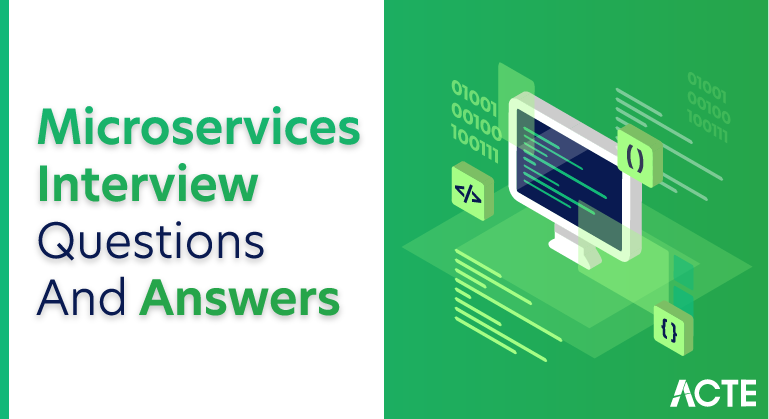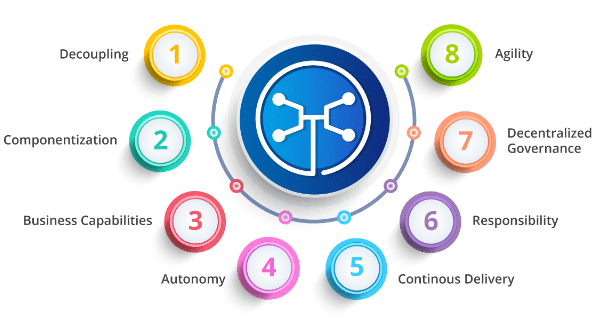
Microservices is an architectural paradigm that designs software applications as a collection of small, independent services, each encapsulating a specific business capability. These services operate as autonomous entities, running in their own processes and communicating through well-defined APIs. One of the key principles of microservices is their ability to empower teams to work independently on different services, enabling decentralized development and deployment. This autonomy extends to technology choices, allowing each service to use the most suitable programming languages and technologies.
1. What are microservices?
Ans:
Microservices are software architectural style in which application is divided into the small, loosely coupled services that can be developed, deployed, and maintained independently.
Each service in the microservices architecture focuses on specific business capability and communicates with the others through well-defined APIs.
2. What are main advantages of using microservices?
Ans:
- Scalability
- Flexibility
- Continuous delivery
- Fault isolation
3. How microservices architecture promote (CI/CD)?
Ans:
Microservices architecture promotes the CI/CD by facilitating the independent development and deployment of each service. Since microservices are loosely coupled, teams can work on independently. This makes it easier to add a new features, fix bugs, and perform the updates without affecting the entire system.
4. What are the main components of Microservices?
Ans:
- Containers, Clustering, and Orchestration
- IaC [Infrastructure as Code Conception]
- Cloud Infrastructure
- API Gateway
- Enterprise Service Bus
- Service Delivery
5. List down the main features of Microservices.
Ans:
Decoupling: Services are the generally disconnected inside a system. As a result, the application as whole may be simply built, modified, and scaled.
Componentization: Microservices are the considered discrete components that can be simply a swapped out or improved.
Business Capabilities: Microservices are the small and focused on a single service.
Team autonomy: Each developer works autonomously, resulting in the shorter project timeframe.

6. While using Microservices, mention challenges that are faced?
Ans:
- Microservices are constantly interdependent. As a result, they must be communicate with one another.
- It’s complicated model because it’s the distributed system.
- If going to use Microservice architecture, be prepared for a some operational overhead.
- To handle the heterogeneously dispersed Microservices, will require trained people.
7. Describe Docker in microservices deployment.
Ans:
Docker plays the vital role in microservices deployment by providing a containerization. Each microservice and its dependencies are packaged into the lightweight, isolated containers.
Docker ensures that each container runs consistently across the different environments such as development, testing, and production. This avoids notorious it works on machine issue.
8. What is API gateway in microservices?
Ans:
An API gateway in the microservices acts as a central entry point that handles the client requests and then routes them to appropriate microservices. It serves several purposes:
- Aggregation
- Load balancing
- Caching
- Protocol translation
9. What are key challenges in migrating from monolithic to microservices?
Ans:
Decomposition complexity: Identifying a right service boundaries and breaking down the monolith into cohesive microservices requires the careful analysis and planning.
Data management: Handling data in the distributed environment becomes the more complex as transactions may span multiple microservices.
Inter-service communication: Ensuring an efficient and reliable communication between the microservices is crucial to avoid performance bottlenecks and failure cascades.
10. List characteristics of well-designed microservices architecture.
Ans:
- Single responsibility principle
- Loose coupling
- Independent deployment
- Resilience
11. How do microservices ensure fault tolerance in distributed systems?
Ans:
Redundancy: The system can continue to function even in the event that some instances fail by duplicating the microservices across numerous instances and potentially across separate data centers.
Circuit breaker pattern: Microservices implement the circuit breakers to prevent the cascading failures.
Bulkheads: Microservices are the isolated from each other. Failures in a one service don’t affect others, containing potential damage.
12. Explain principles of Conway’s Law.
Ans:
Conway’s Law states that structure of a software system will mirror communication structures of the organization that builds it.
This implies that a development team’s communication and cooperation patterns will be reflected in the design of microservices.
13. What are essential components of microservices communication?
Ans:
- APIs (application programming interfaces)
- Message brokers
- REST (representational state transfer)
- Service discovery
14. Discuss about the connection between DevOps and Microservices.
Ans:
Faster deployment: Microservices facilitate quick development and deployment because of their smaller codebases and well defined boundaries.
Automation: Microservices and DevOps rely heavily on the automation. Microservices encourage the automation for testing, deployment, and scaling, while DevOps emphasizes automating entire software delivery process.
Collaboration: The microservices approach are breaks down monolithic barriers, enabling smaller, cross-functional teams that are work collaboratively.
Resilience and monitoring: DevOps principles of the monitoring and observability align with need for resilient microservices where the continuous monitoring helps identify and address issues promptly.
15. How is WebMvcTest annotation used in Spring MVC applications?
Ans:
The @WebMvcTest annotation in Spring MVC is used to test the web layer of an application in isolation. It focuses on controllers by auto-configuring a Spring test environment with only the necessary components for testing controllers. This allows developers to write concise and targeted tests for their web layer, enabling efficient unit testing without the need for a complete application context.
16. How decide the appropriate size of microservice?
Ans:
Clear Responsibilities: Assign distinct roles to each microservice and group related functions together.
Domain Alignment: Align with specific business domains and let microservices manage their data.
Scalability and Autonomy: Design for independent scalability and allow autonomous deployment.
Efficient Communication: Minimize inter-service communication.
Resilience: Build fault tolerance and consider team size and expertise.
17. What is the purpose of the WebMvcTest annotation in Spring MVC applications?
Ans:
The @WebMvcTest annotation in Spring MVC is used to test the web layer of an application in isolation. It focuses on controllers by auto-configuring a Spring test environment with only the necessary components for testing controllers. This allows developers to write concise and targeted tests for their web layer, enabling efficient unit testing without the need for a complete application context.
18. How handle database management efficiently in microservices?
Ans:
Database per service: Each microservice should have its database to ensure the loose coupling between services and avoid a complex shared databases.
Eventual consistency: In distributed systems, ensuring the immediate consistency across all the services can be challenging.
Sagas: Implementing sagas (a sequence of local transactions) can maintain a data consistency across the multiple services, even in the face of failures.
19. List the benefits of using Kubernetes for microservices orchestration.
Ans:
Scalability: Effortless scaling.
Fault Tolerance: Automated recovery.
Resource Efficiency: Optimal utilization.
Service Discovery: Simplified communication.
Rolling Updates: Seamless deployment.
20. What is service discovery
Ans:
Service discovery is the vital aspect of microservices architecture that enables a dynamic and automatic detection of services within system.
Service discovery allows each service to register itself with the central registry or service mesh and obtain information about the other services’ locations and endpoints.
21. What are best practices for securing communication between microservices?
Ans:
Transport Layer Security (TLS): Enforce the TLS encryption for communication over network to ensure data confidentiality and integrity.
Authentication and authorization: Implement a strong authentication mechanisms to verify identity of microservices. Use the access control and role-based authorization to restrict access to sensitive APIs.
Use API gateways: Channel all the external communication through API gateway.
22. Explain Materialized View pattern.
Ans:
When need to design the queries that retrieve data from the various Microservices, can leverage the Materialized View pattern as a method for aggregating data from the numerous microservices.
In this method, create a read-only table with data owned by more Microservices in advance (prepare denormalized data before real queries). The table is formatted to meet demands of a client app or API Gateway.
23. How microservices architecture facilitate rolling updates?
Ans:
Microservices architecture facilitates rolling updates through its modular and independent service structure. Each microservice operates as a self-contained unit, enabling updates to be deployed incrementally without affecting the entire system. During a rolling update, one or more instances of a microservice are updated while others continue running, ensuring uninterrupted service availability.
24. Differentiate microservices with serverless architecture.
Ans:
| Aspect | Microservices | Serverless | |
| Compute Model |
Run on dedicated servers/containers. |
On-demand execution without server management. | |
| Scaling | Adjust instances for scalability. | Auto-scales based on demand. | |
| Infrastructure | Requires infrastructure management. | Abstracts infrastructure details. | |
| Execution Duration |
Handles long-running processes. |
Designed for short-lived tasks. |
25. What is message broker in asynchronous microservices communication?
Ans:
- A message broker plays the crucial role in enabling asynchronous communication between the microservices.
- It acts as intermediary that facilitates the exchange of messages between the microservices without requiring them to interact directly in real time.
26. Are containers similar to a virtual machine?
Ans:
No, containers are more different from a virtual machines. Containers, unlike a virtual machines, do not need to boot operating system kernel, hence they may be built-in under a second. This characteristic distinguishes container-based virtualization from the other virtualization methods.
27. Describe API-first design.
Ans:
- API-first design is approach where a design of APIs (application programming interfaces) drives entire software development process.
- It emphasizes defining the API contract and specifications before implementing underlying logic.
28. Explain 12-factor app methodology.
Ans:
The best techniques for creating contemporary, scalable, and maintainable online apps, especially when working with cloud-based and microservices architectures, are outlined in the 12-factor app methodology.
Its significance in microservices development lies in the providing guidelines to create robust and portable services that can work seamlessly in the distributed environments.
29. How do microservices handle security and authentication?
Ans:
API gateways: Microservices often utilize the API gateway which acts as a single entry point to system and enforces security policies like authentication and authorization for all the incoming requests.
OAuth and JWT: These standards are the commonly used for user authentication and issuing secure access tokens to be enable secure communication between services.
Role-based access control (RBAC): RBAC is employed to be manage permissions and restrict access to the certain microservices based on roles of the users or services.
30. Define configuration management tools in microservices.
Ans:
Configuration management tools play the crucial role in microservices environments, facilitating dynamic and centralized management of configuration settings for individual services.
As a microservices are designed to be independently deployable, having centralized configuration management system is essential to prevent hard-coding configurations, which can lead to the complexities and versioning issues.
31. What are event-driven architectures (EDAs)?
Ans:
EDAs are systems where services communicate through exchange of events rather than direct request-response interactions. An event can represent a significant occurrence or state change within service.
It is typically published to message broker or event bus. Other services, which have interest in such events, can subscribe to event and react accordingly.
32. Explain importance of log aggregation and centralized logging.
Ans:
- Log aggregation consolidates the logs from multiple sources into centralized repository, simplifying log analysis and providing the holistic view of the system’s health and performance.
- Centralized logging allows the developers and operations teams to search, filter, and analyze logs easily, making it quicker to identify and resolve issues.
33. How Micro Frontends complement microservices in front-end development space?
Ans:
Micro Frontends is architectural pattern that complements microservices approach by extending the concept of independently deployable and scalable services to the front-end.
In traditional monolithic front-end architectures, making the changes to one part of front-end often requires redeploying the entire application. This leads to be coupling and potential bottlenecks in the development and release cycles.
34. Discuss challenges in distributed transactions in microservices.
Ans:
- Maintaining a transactional consistency across the multiple services and databases.
- Handling partial failures or rollbacks when a one or more services encounter errors.
- Avoiding the long-running transactions that impact system performance and scalability.
- Managing the distributed locks and preventing deadlocks.
35. Explain eventual consistency in microservices databases.
Ans:
Eventual consistency is the consistency model used in the distributed systems, including microservices databases, that allows a data replicas to become consistent over time without need for immediate synchronization.
In eventual consistency, updates to a data are propagated asynchronously to various nodes. There may be short period during which different replicas may contain the different versions of the data.
36. What is CQRS?
Ans:
CQRS is a design pattern that separates a read and write operations for a data store. In traditional monolithic applications, single model serves both read and write requests, leading to the complex data access logic. CQRS addresses this by segregating responsibilities of handling write (commands) and read (queries) operations into a separate components.
37. How does ensure data privacy and compliance in microservices ecosystem?
Ans:
- Ensuring data privacy and compliance in a microservices ecosystem involves implementing robust security measures and adherence to regulatory standards.
- Encryption of data in transit and at rest, stringent access controls, and identity management mechanisms are essential.
38. Explain event sourcing in building scalable microservices.
Ans:
Event sourcing is the data modeling technique used to capture and persist all changes to application’s state as a sequence of events. Rather than storing the current state of entity, event sourcing stores log of events that have occurred over time, representing a state transitions.
39. Explain principles of domain-driven design (DDD).
Ans:
Universal language: Establishes the common language that is shared by domain experts and developers to be ensure clear communication and understanding of the domain.
Bounded contexts: Divides application into the distinct bounded contexts, where each context represents the specific subdomain with its own rules and constraints.
Aggregates: Defines the aggregates as consistency boundaries, ensuring thatstate of an aggregate can only be modified through the well-defined operations.
Domain events: Uses domain events to communicate the changes and state transitions within domain.
40. Describe blue-green deployment strategy
Ans:
Blue-green deployment is the deployment strategy that involves the running two identical environments (blue and green) and switching between them during software updates or releases.
In microservices setup, this strategy can be applied at service level, allowing for a seamless updates of individual services while maintaining overall the system availability.
41. How can achieve auto-scaling in microservices architecture?
Ans:
Achieving the auto-scaling involves the following steps:
Monitoring: Implement a robust monitoring of key performance metrics like CPU usage, memory consumption, request latency, and throughput for each service.
Scaling policies: Define the scaling policies based on the monitored metrics.
Load balancing: Employ load balancing mechanisms to be distribute incoming traffic evenly among available instances.
42. What are popular tools used for microservices development?
Ans:
- Spring Boot
- Node.js
- Docker
- Kubernetes
- Istio
- Netflix OSS
- RabbitMQ, Kafka
43. Explain importance of fault isolation in microservices.
Ans:
Resilience: Fault isolation prevents the cascading failures.
Improved debugging: Isolated services are simplify debugging and troubleshooting.
Independent scaling: Services can be scaled independently based on specific resource requirements and workloads.
44. Describe API gateway pattern.
Ans:
The API gateway pattern is the central component in microservices architecture that acts as entry point for all client requests, providing a unified and simplified interface to interact with the multiple microservices. It serves as reverse proxy and front-end aggregator, allowing the clients to communicate with the entire microservices ecosystem through single endpoint.
45. What are different approaches for service-to-service communication?
Ans:
Considering the microservice architecture concept, each microservice needs to have an interface. Based on the principles of open networking of the Web, RESTful APIs provide the most logical model for building interfaces between the various components of the microservices architecture. RESTful APIs can be accessed in two ways:
HTTP/REST: The most common approach is using the HTTP with a RESTful API. This approach is simple, widely understood, and easy to implement, making it popular choice for a microservices communication.
gRPC: gRPC is an RPC (remote procedure call) framework developed by a Google. It uses the Protocol Buffers for serialization and support for the multiple programming languages.
Message brokers: Message brokers like a RabbitMQ and Apache Kafka facilitate the asynchronous communication between services.
46. What is saga pattern to manage distributed transactions in microservices?
Ans:
The saga pattern is the design pattern used to manage distributed transactions in the microservices architecture. It is an alternative to traditional two-phase commit protocol, which becomes a cumbersome and impractical in the distributed system.
47. Define bulkhead pattern.
Ans:
- The bulkhead pattern is the design principle borrowed from shipbuilding.
- Multiple compartments (bulkheads) are used to isolate ship’s sections, preventing the entire vessel from a flooding in case of damage.
- In microservices architecture, the bulkhead pattern is used to isolate the components and limit the impact of failures.
48. Explain pros and cons of event-driven architecture in microservices.
Ans:
Decoupling: Services in event-driven architecture are the loosely coupled.
Scalability: Event-driven systems can scale more easily as a services can handle events independently.
Complexity: Implementing event-driven systems can introduce the additional complexity.
Event duplication: Events can be duplicated in the some scenarios, leading to potential data inconsistencies.
49. What is circuit breaker pattern?
Ans:
- The circuit breaker pattern is the fault-tolerance pattern used in microservices to manage the impact of the failing services.
- It prevents the system-wide failures by providing a way to gracefully handle the faults and failures in distributed systems.
50. How can achieve service orchestration and choreography in microservices?
Ans:
Service orchestration: In service orchestration, central component takes on the responsibility of coordinating a flow of the entire business process.
Choreography: The choreography approach is decentralized, and the interactions between the services are based on predefined contracts or a protocols.
51. How implement distributed authorization and access control in microservices?
Ans:
Implementing distributed authorization and access control in the microservices architecture involves an ensuring that each microservice enforces access control independently.
The goal is to prevent the unauthorized access to resources and actions while maintaining the consistent and secure authentication mechanism across entire system.
52. Explain API documentation and discoverability in microservices ecosystems.
Ans:
API documentation and discoverability play the crucial role in microservices ecosystems to facilitate smooth interactions between the services and enable effective collaboration among the development teams.
53. Explain service mesh in microservices communication and security.
Ans:
- A service mesh plays the crucial role in facilitating communication and enhancing security in microservices environment.
- It is the dedicated infrastructure layer that abstracts away service-to-service communication complexities from the individual microservices.
54. How to achieve data partitioning in microservices?
Ans:
Data partitioning is essential in the microservices to effectively handle large datasets.One common approach is horizontal partitioning, where data is distributed across the multiple databases based on a specific criterion like a customer ID or date range. This ensures each microservice only deals with the subset of the data, which improves the performance and scalability.
55. How to implement canary testing for microservices architecture?
Ans:
Canary testing is the deployment strategy that allows gradual release of new microservices versions to the subset of users. To implement canary testing, first deploy a new version to a small group of servers or instances, serving only fraction of the user traffic. then closely monitor the behavior and performance of the canary version. If everything goes well, gradually increase the rollout to the larger audience.
56. What are best practices for handling security vulnerabilities and in microservices?
Ans:
- Handling security vulnerabilities in the microservices requires a proactive and multi-layered approach.
- Regular security audits, code reviews, and vulnerability scanning are essential.
- Applying the security patches promptly and staying up-to-date with the security best practices are crucial.
- Secure communication between services using the HTTPS or mTLS ensures a data confidentiality and integrity.
57. Discuss trade-offs between synchronous and asynchronous communication.
Ans:
Synchronous communication involves the direct request-response interactions between the services, where a service waits for response before proceeding.
On other hand, asynchronous communication decouples the services and improves resilience. Services communicate through the messages or events, allowing them to process requests independently and at own pace.
58. Explain contract testing in microservices environment.
Ans:
- Contract testing is essential in microservices environment to ensure compatibility and reliability between the services.
- It involves testing contracts or agreements established between the services when they interact with each other.
- These contracts define expected inputs, outputs, and behaviors of each service.
59. What are key performance metrics to monitor in microservices architecture?
Ans:
Response time: Measure time taken to process requests, both the individual services and end-to-end flow.
Error rate: Monitor the rate of errors, like HTTP 500 responses, to identify service failures and disruptions.
Throughput: Measure number of requests processed per unit of time to understand a system’s overall workload.
60. Difference between monitoring and observability in microservices.
Ans:
Monitoring involves the collecting and analyzing metrics and logs from the various components in the system. It provides the insights into the health, performance, and resource usage of individual services.
Observability, on other hand, focuses on understanding the system’s internal behavior based on a real-time data and traces. It involves the gathering fine-grained information about the interactions between the services.
61. Define health checks and readiness probes in Kubernetes.
Ans:
Health checks: These are periodic checks performed by the Kubernetes to determine if a container is healthy and capable of a serving requests.
Readiness probes: Readiness probes determine if container is ready to receive incoming traffic. If readiness probe fails, Kubernetes removes container from service until it becomes healthy again.
62. Explain centralized logging.
Ans:
- Centralized logging involves the aggregating logs from the multiple microservices into a central location, making it easier to monitor and analyze application behavior across entire system.
- In microservices environments, each service generates its logs independently which can lead to the challenges when troubleshooting and correlating events.
63. How to identify and address performance bottlenecks?
Ans:
Monitor and Optimize: Track metrics, profile code, optimize queries, implement caching.
Traffic and Concurrency: Balance traffic, manage concurrency.
Code and Network Efficiency: Review, optimize code, network configurations.
Hardware and Parallelism: Evaluate, upgrade hardware, explore parallel processing.
Error Management: Promptly address errors, examine logs.
64. Define the importance of capacity planning in microservices.
Ans:
Capacity planning in microservices is vital for maintaining performance and preventing disruptions. It allows for efficient resource allocation, ensuring that the dynamic and decentralized nature of microservices architecture can scale seamlessly to meet changing workloads, enhancing system resilience and responsiveness while optimizing infrastructure costs.
65. What are the challenges of testing microservices in isolation?
Ans:
- Interdependencies and Communication
- Data and State Complexity
- External Dependencies and Orchestration
- Versioning and Compatibility Issues
- Performance Testing Challenges
66. Describe service virtualization in microservices testing.
Ans:
Service virtualization is the technique used in microservices testing to simulate behavior of dependent services that are not available or impractical to test directly in current testing environment. This approach allows developers to test the microservice in isolation by replacing its dependencies with the virtualized representations.
66. How does implement end-to-end testing for microservices applications?
Ans:
Implementing end-to-end testing for microservices requires defining comprehensive scenarios that span multiple services. Establish a mirrored testing environment, employ automated tools for efficient execution, use mocks to isolate microservices, and maintain regular updates for evolving application changes.
67. Discuss strategies to achieve blue-green deployment in CI/CD pipeline.
Ans:
Automated Infrastructure: Automate resource provisioning.
Incremental Deployment with Testing: Gradual shift with automated testing.
Rollback Planning and Mechanism: Define and automate rollback.
Dynamic Feature Control: Use feature flags for dynamic control.
Monitoring and Load Balancer: Implement monitoring and adjust load balancing.
68. Explain feature toggles in progressive deployment of microservices.
Ans:
Risk mitigation: New features can be hidden from the users initially, reducing a risk of unexpected issues and negative user experiences.
Gradual rollout: Feature toggles facilitate the gradual rollout of new features to subset of users, allowing the developers to monitor the impact and collect feedback before a full release.
A/B testing: Feature toggles enable A/B testing, where a different groups of users experience different versions of application. This helps evaluate the effectiveness of a new features.
69. How to ensure database schema evolution in CI/CD microservices setup?
Ans:
- In a CI/CD microservices setup, ensure seamless database schema evolution by incorporating version-controlled database scripts.
- Maintain a structured approach to migrations, creating scripts that handle changes incrementally.
- Integrate automated testing for database migrations to detect issues early in the development pipeline.
70. Describe Zero Trust security model.
Ans:
The Zero Trust security model is based on principle of “never trust, always verify.” It assumes that no user or service can be trusted by default, even if they are inside a network perimeter. The Zero Trust model aims to secure access to resources by continuously verifying the user identity, device integrity, and other factors, regardless of their location.
71. Explain JWT for authentication and authorization in microservices.
Ans:
Authentication: When user logs in, the authentication server generates the JWT containing user information and signs it using secret key. The JWT is then sent back to a client.
Authorization: The client includes JWT in subsequent requests to microservices in authorization header. Microservices validate JWT’s signature using the same secret key as authentication server.
72. Describe rate limiting and throttling.
Ans:
- Rate limiting and throttling are techniques used to control a number of requests a client can make to the microservice within a specified period.
- They are used to prevent abuse, limit the resource consumption, and protect microservices from the overload or DDoS attacks.
73. How can implement retry, timeout, and fallback in microservices?
Ans:
Retry: When microservice encounters a transient error, it can automatically retry operation a predefined number of times.
Timeout: Set appropriate timeouts for a service-to-service communication. If service does not respond within a specified time, the requester can handle the timeout scenario gracefully and, if needed, trigger retries.
Fallback: Define the fallback mechanisms or alternative responses to handle the failures gracefully.
74. Describe secret management and rotation in microservices security.
Ans:
Secret management and rotation are the crucial components of microservices security to protect a sensitive information such as API keys, database passwords, and authentication tokens.
75. How do implement microservices using Spring Boot?
Ans:
Set up Spring Boot project: Create the new Spring Boot project using Spring Initializr or your preferred IDE.
Define microservice boundaries: Identify a distinct functionalities and boundaries for each microservice.
Create microservices: Implement the each microservice as a separate module in the Spring Boot project.
Define APIs: Design RESTful APIs for an intercommunication between the microservices and external clients.
Use Spring Data JPA: Use Spring Data JPA to interact with the databases and simplify data access.
76. Explain Spring Cloud in building Java-based microservices.
Ans:
- Spring Cloud is the set of tools and frameworks provided by Spring ecosystem to simplify the development of distributed systems and microservices in Java.
- It offers the various components that address a common challenges in microservices architectures.
77. What is Monolithic Architecture?
Ans:
Monolithic architecture is like big container in which all software components of an application are clubbed inside the single package.
78. List out the benefits of using Spring Cloud Config Server.
Ans:
- Centralized configuration
- Externalized configurations
- Versioned configurations
- Environment-specific configurations
- Security
79. What is RESTful?
Ans:
Representational State Transfer (REST)/RESTful web services is architectural style that helps the computer systems to communicate over internet. These web services make the microservices easier to understand and implement.
80. Name three commonly used tools for Microservices.
Ans:
- WireMock
- Docker
- Hystrix
81. What is OAuth?
Ans:
OAuth means the open authorization protocol. This protocol allows to access the client applications on HTTP for a third-party providers GitHub, Facebook, etc. It helps to share resources stored on one site with the another site without the need for credentials.
82. Explain the use of PACT in Microservices architecture.
Ans:
- It is open source tool which allows the testing interactions between service providers and consumers.
- However, it is a separated from the contract made. This increases the reliability of Microservices applications.
83. What are micro frontends, and how do they complement microservices?
Ans:
Definition: Micro frontends extend the microservices concept to the frontend, allowing teams to independently develop, test, and deploy frontend components.
Complement to Microservices: They align with the decentralized, independently deployable nature of microservices, enabling frontend teams to work autonomously.
84. Explain the relationship between serverless computing and microservices.
Ans:
Serverless computing complements microservices by abstracting infrastructure management. Microservices can leverage serverless functions for specific tasks, enhancing scalability and reducing operational overhead.
85. Describe common resilience patterns used in microservices architecture.
Ans:
- Common Patterns: Retry mechanisms, timeout settings, and circuit breakers.
- Purpose: Enhance system robustness by handling transient failures gracefully and preventing cascading failures.
86. What are cross-cutting concerns in microservices?
Ans:
Cross-cutting concerns, like logging and security, affect multiple microservices. Implement aspect-oriented programming or use frameworks to encapsulate and manage cross-cutting concerns.
87. Explain the benefits of asynchronous communication between microservices.
Ans:
- Decouples microservices, improve scalability, and enhances responsiveness.
- Message queues and event-driven patterns enable asynchronous communication, supporting loose coupling.
88. How does microservices architecture align with DevOps principles?
Ans:
Microservices embrace DevOps principles by promoting collaboration, automation, continuous integration, and continuous delivery.
Benefits are Faster development cycles, improved deployment frequency, and enhanced collaboration between development and operations teams.
89. Describe various deployment strategies for microservices.
Ans:
Options: Blue-Green Deployment, Canary Release, and A/B Testing.
Purpose: Minimize downtime, reduce risk, and enable controlled feature rollouts.
90. How do microservices function in a cloud-native environment?
Ans:
Microservices leverage cloud-native principles like containerization, orchestration (e.g., Kubernetes), and elastic scaling. Some of its benefits are Scalability, flexibility, and resilience in dynamic cloud environments.






